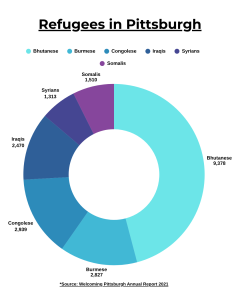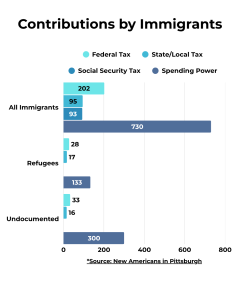 By Tika Shankar, Development Intern, SHIM
By Tika Shankar, Development Intern, SHIM
Pittsburgh, the place so many of us call home is not home to just one culture or background. Walk through any neighborhood, step into a local store, or sit in a school cafeteria, and you’ll experience the vibrant diversity all around us. You can smell the spices drifting from kitchen windows, hear different languages spoken on every block, and see neighbors from all over the world building their lives here.
But have you ever wondered, where do your neighbors come from? 
Our mid-sized city in Allegheny County, Pennsylvania, has a population of 302,971 according to data from 2020, of which 66.4% of residents are White, 23% are Black, 5.8% are Asian, and 3.4% are Hispanic or Latinx. In this mix, 26,254 refugees have arrived in Pittsburgh between 2010 and 2019. Among the refugees included, are Bhutanese (9,378), Burmese (2,827), Congolese (2,939), Iraqis (2,470), Syrians (1,313), and Somalis (1,510). Since 2019, there has been an influx of Afghan refugees, especially in the fall of 2021, as Pittsburgh was one of the 19 cities recommended by the US Department of State to resettle Afghan refugees along with Ukrainian arrivals in 2022 (Welcoming Pittsburgh Annual Report 2021). While these numbers reflect Allegheny County, the heart of this change can be seen in the South Hills, where neighborhoods like Baldwin and Whitehall have become a home for many of the refugees. In these communities, SHIM plays a key role in helping newcomers adjust. Starting with the basics like food, clothing and programs for youth and families, SHIM supports immigrant and refugee families as they build a new life here. Shekewa, an Afghan resident of Baldwin who is also a SHIM pantry participant, has shared her experience as a newcomer:
“Afghanistan is not safe now and we cannot go back. Therefore, we must call this place our new home, at least for the sake of our children’s future. The biggest struggle I face right now is language barrier. Without the language knowledge, I cannot do anything especially with my 3-year-old child. Coming out to the SHIM food pantry allows me to get out of my house and interact with the community so it makes me more comfortable to get used to this new environment while taking basic needs things for home to feed my family.” 
SHIM provides more than just groceries. For newcomers like Shekewa, the pantry is also a place to connect, build confidence, and begin adjusting to life in a new environment.
 Economic growth accompanied this growing immigrant population, as these diverse neighbors contribute greatly to our region’s economy. Immigrants and refugees in Pittsburgh work hard, raise families, and play a vital role in our region’s economy. According to New Americans in Pittsburgh, in 2019, immigrant households in Pittsburgh earned $1 billion to which $202.9 million went to federal taxes, $95.1 million went to state and local taxes, $730.8 million was left in spending power, $93.9 million to Social Security, and $26.8 million to Medicare. Refugees alone, around 8.7% of local immigrants, earned $179.2 million to which $28.3 million went to federal taxes, $17.8 million went to state and local taxes, and $133 million was left in spending power. Even undocumented immigrants, often labeled unfairly as “takers”, contributed significantly. Approximately 11,600 undocumented immigrants, about 16% of the immigrant population, earned $350.0 million to which $33.8 million went to federal taxes, $16.3 million went to state and local taxes, and $300 million was left in spending power. These numbers shatter the harmful myth that immigrants and refugees are a burden.
Economic growth accompanied this growing immigrant population, as these diverse neighbors contribute greatly to our region’s economy. Immigrants and refugees in Pittsburgh work hard, raise families, and play a vital role in our region’s economy. According to New Americans in Pittsburgh, in 2019, immigrant households in Pittsburgh earned $1 billion to which $202.9 million went to federal taxes, $95.1 million went to state and local taxes, $730.8 million was left in spending power, $93.9 million to Social Security, and $26.8 million to Medicare. Refugees alone, around 8.7% of local immigrants, earned $179.2 million to which $28.3 million went to federal taxes, $17.8 million went to state and local taxes, and $133 million was left in spending power. Even undocumented immigrants, often labeled unfairly as “takers”, contributed significantly. Approximately 11,600 undocumented immigrants, about 16% of the immigrant population, earned $350.0 million to which $33.8 million went to federal taxes, $16.3 million went to state and local taxes, and $300 million was left in spending power. These numbers shatter the harmful myth that immigrants and refugees are a burden.
You truly don’t have to look far to see the impact immigrants have on our daily lives. In South Hills neighborhoods like Brentwood, Baldwin, and Whitehall, immigrant-owned restaurants and businesses line the main streets, offering everything from Himalayan momos to Vietnamese soothing Pho broths. These businesses don’t just serve food, they create gathering spaces, offer jobs, and bring flavor to the region. As highlighted by PublicSource, these immigrant entrepreneurs are “anchoring local economies” and helping revitalize entire corridors. Many are refugees who once struggled but are now giving back by feeding and employing their community. They are taxpayers, entrepreneurs, caregivers, community builders, and essential members of our workforce.
Behind every number is a neighbor with a story- someone who came here seeking safety, opportunity, or simply a chance to live without fear.
 One Baldwin pantry participant shared that, “My family left Bhutan when I was young due to ethnic and religious persecution. I spent most of my life in the refugee camps and I still find it a struggle to meet basic needs here in the US. I have an elderly mother and a 2-year-old baby. So, with just me working full-time, I can’t take care of everything. I am happy to have found SHIM because they help with food and baby things so that I can focus more on the home bills and other stuff.”
One Baldwin pantry participant shared that, “My family left Bhutan when I was young due to ethnic and religious persecution. I spent most of my life in the refugee camps and I still find it a struggle to meet basic needs here in the US. I have an elderly mother and a 2-year-old baby. So, with just me working full-time, I can’t take care of everything. I am happy to have found SHIM because they help with food and baby things so that I can focus more on the home bills and other stuff.”
As the South Hills becomes more culturally diverse, spaces that promote understanding and support to these communities are more important than ever. Since 1968, SHIM has been there for the community not just as a service provider, but as a connector of neighbors from all around the world.
For newly arrived families navigating a new language, culture, and the American system, SHIM offers more than food or clothing. Programs like parenting classes and youth programs help families from immigrant backgrounds succeed. Kids and teens especially thrive with SHIM’s support, in school and in building friendships that cross cultural lines.
One former participant shared, “Being involved with SHIM’s Girl’s Group program helped me even more as I grew because it helped me connect with so many other girl’s my age of all backgrounds and has given me some of the best memories and lifelong friendship.” 
SHIM also supports adults through financial advising and community gardens, creating shared spaces where people grow food, confidence, and community side by side. In a region as diverse as the South Hills, SHIM helps ensure that everyone, no matter where they’re from, feels they belong.
So, where do your neighbors come from? The answer might be Bhutan, Afghanistan, Kenya, Myanmar, Palestine, Thailand, Syria, and more. But more importantly, what do they contribute? Your neighbors bring vibrant culture, and a sense of uniqueness to our community. So, when we welcome each other not just with services, but with compassion for one and another, we build more than neighborhoods. We build a home for all.
Join SHIM in making the South Hills a place where every neighbor belongs.

